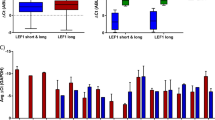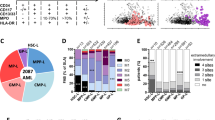Abstract
Activation of the Wnt/β-catenin pathway has recently been shown to be crucial to the establishment of leukemic stem cells in chronic myeloid leukemia. We sought to determine whether β-catenin was correlated to clonogenic capacity also in the acute myeloid leukemia (AML) setting. Eighty-two patients were retrospectively evaluated for β-catenin expression by Western blot. β-Catenin was expressed (although at various protein levels) in 61% of patients, and was undetectable in the remaining cases. In our cohort, β-catenin expression was correlated with the clonogenic proliferation of AML-colony forming cells (AML-CFC or CFU-L) in methylcellulose in the presence of 5637-conditioned medium, and more strikingly with self-renewing of leukemic cells, as assessed in vitro by a re-plating assay. In survival analyses, β-catenin appeared as a new independent prognostic factor predicting poor event-free survival and shortened overall survival (both with P<0.05). Furthermore, variations in β-catenin protein levels were dependent on post-transcriptional mechanisms involving the Wnt/β-catenin pathway only in leukemic cells. Indeed, β-catenin negative leukemic cells were found to increase β-catenin in response to Wnt3a agonist in contrast to normal counterparts. Altogether, our data pave the way to the evaluation of Wnt pathway inhibition as a new rationale for eradicating the clonogenic pool of AML cells.
This is a preview of subscription content, access via your institution
Access options
Subscribe to this journal
Receive 12 print issues and online access
$259.00 per year
only $21.58 per issue
Buy this article
- Purchase on Springer Link
- Instant access to full article PDF
Prices may be subject to local taxes which are calculated during checkout



Similar content being viewed by others
References
Pardal R, Clarke MF, Morrison SJ . Applying the priciples of stem cells biology to cancer. Nat Rev Cancer 2003; 3: 895–902.
Reya T, Morrison S, Clarke M, Weissman I . Stem cells, cancer, and cancer stem cells. Nature 2001; 414: 105–111.
Polakis P . Wnt signalling and cancer. Genes Dev 2000; 14: 1837–1851.
Giles RH, van Es JH, Clevers H . Caught up in a Wnt storm: Wnt signaling in cancer. Biochim Biophys Acta 2003; 1653: 1–24.
van Es JH, Barker N, Clevers H . You Wnt some, you lose some: oncogenes in the Wnt signaling pathway. Curr Opin Genet Dev 2003; 13: 28–33.
Moore MAS, Spitzer G, Williams G, Metcalf D, Buckley J . Agar culture studies in 127 cases of untreated acute leukemia: the prognostic value of reclassification of leukemia according to in vitro growth characteristics. Blood 1994; 44: 1–18.
Vincent PC, Sutherland R, Bradley M, Lind D, Gunz FW . Marrow culture studies in acute leukemia at presentation and during remission. Blood 1977; 49: 903–912.
Del Canizo M, Brufau A, Almeida J, Galende J, Garcia Marcos MA, Mota A et al. In vitro growth in acute myeloblastic leukemia: relationship with other clinico-biological characteristics of the disease. Br J Haematol 1998; 103: 137–142.
Van den Berg D, Sharma A, Bruno E, Hoffman R . Role of members of the Wnt gene family in human hematopoiesis. Blood 1998; 92: 3189–3202.
Austin T, Solar G, Ziegler F, Liem L, Matthews W . A role for the Wnt gene family in hematopoiesis: expansion of multilineage progenitor cells. Blood 1997; 89: 3624–3635.
Reya T, Duncan AW, Ailles L, Domen J, Scherer D, Willert K et al. A role for Wnt signalling in self-renewal of haematopoietic stem cells. Nature 2003; 23: 409–414.
Willert K, Brown JD, Danenberg E, Duncan A, Weissman IL, Reya T et al. Wnt proteins are lipid-modified and can act as stem cell growth factors. Nature 2003; 423: 448–452.
Staal FJ, Clevers HC . WNT signalling and haematopoiesis: a WNT-WNT situation. Nat Rev Immunol 2005; 1): 21–30.
Brandon C, Eisenberg LM, Eisenberg CA . Wnt signaling modulates the diversification of hematopoietic cells. Blood 2000; 96: 4132–4141.
Lu D, Zhao Y, Tawatao R, Cottam H, Sen M, Leoni LM et al. Activation of the Wnt signaling pathway in chronic lymphocytic leukemia. Proc Natl Acad Sci USA 2004; 101: 3118–3123.
Qiang YW, Endo Y, Rubin JS, Rudikoff S . Wnt signaling in B-cell neoplasia. Oncogene 2003; 22: 1536–1545.
Derksen P, Tijn E, Meijer H, Klok MD, MacGillavry MH, van Oers MH et al. Illegitimate Wnt signaling promotes proliferation of multiple myeloma cells. Proc Natl Acad Sci USA 2004; 101: 6122–6127.
Jamieson C, Ailles L, Dylla S, Muijtjens M, Johnes C, Zehnder JL et al. Granulocyte-macrophage pogenitors as candidate leukemic stem cells in blast-crisis CML. N Engl J Med 2004; 351: 657–667.
Müller-Tidow C, Steffen B, Cauvet T, Tickenbrock L, Ji P, Diederichs S et al. Translocation products in acute myeloid leukemia activate the Wnt signaling pathway in hematopoietic cells. Mol Cell Biol 2004; 24: 2890–2904.
Zheng X, Beissert T, Kukoc-Zivojnov N, Puccetti E, Altschmied J, Strolz C et al. catenin contributes to leukemogenesis induced by AML-associated translocation products by increasing the self-renewal of very primitive progenitor cells. Blood 2004; 103: 3535–3543.
Mc Whirter JR, Neuteboom ST, Wancewicz EV, Monia BP, Downing JR, Murre C . Oncogenic homeodomain transcription factor E2A-Pbx1 activates a novel WNT gene in pre-B acute lymphoblastoid leukemia. Proc Natl Acad Sci USA 1999; 96: 11464–11469.
Demur C, Muller C, Cassar G, Bousquet C, Laroche M, Laurent G . Acute myeloid leukemia cells with low p-glycoprotein expression and high Rhodamine 123 efflux capacity display high clonogenicity. Leukemia 1998; 12: 192–199.
Laredo J, Demur C, Muller C, Saivin S, Cassar G, Bousquet C et al. Effects of H-7 and staurosporine on proliferation and self-renewal of acute myeloid leukemia progenitors. Leukemia 1993; 7: 813–820.
Liang H, Chen Q, Coles AH, Anderson SJ, Pihan G, Bradley A et al. Wnt5a inhibits B cell proliferation and functions as a tumor suppressor in hematopoietic tissue. Cancer Cell 2003; 4: 349–360.
Chung EJ, Hwang SG, Nguyen PM, Lee S, Kim JS, Kim JW et al. Regulation of leukemic cell adhesion, proliferation, and survival by β-catenin. Blood 2002; 100: 982–990.
Simon M, Grandage V, Linch D, Khwaja A . Constitutive activation of the Wnt/β-catenin pathway in acute myeloid leukemia. Oncogene 2005; 24: 2410–2420.
Tickenbrock L, Schwable J, Wiedehage M, Steffen B, Sargin B, Choudhary C et al. Flt3 tandem duplication mutations cooperate with Wnt signaling in leukemic signal transduction. Blood 2005; 105: 3699–3706.
Norgaard JM, Langkjer S, Palshof T, Clausen N, Pedersen b, Hokland P . Relation of blast cell survival and proliferation to chemotherapy resistance in AML. Br J Haematol 1996; 93: 888–897.
Richert-Boe KE, Bagby GC . In vitro hematopoiesis in myelodysplasia: liquid and soft-gel culture studies. Hematol Oncol Clin North Am 1992; 6: 543–556.
Hunter A, Rogers S, Roberts I, Barrett AJ, Russel N . Autonomous growth of blast cells is associated with reduced survival in acute myeloblastic leukemia. Blood 1993; 82: 899–903.
Löwenberg B, Van Putten W, Touw I, Delwel R, Santini V . Autonomous proliferation of leukemic cells in vitro as a determinant of prognosis in adult acute myeloid leukemia. N Engl J Med 1993; 328: 614–619.
Ohler L, Berer A, Aletaha D, Kabrna E, Heinze G, Streubel B et al. Cytogenetic risk groups in acute myeloblastic leukemia differ greatly in their semi-solid colony growth. Br J Haematol 2001; 113: 120–125.
Serinsoz E, Neusch M, Busche G, Wasielewski R, Kreipe H, Bock O . Aberrant expression of beta-catenin discriminates acute myeloid leukaemia from acute lymphoblastic leukaemia. Br J Haematol 2004; 126: 313–319.
Tepstra W, Prins A, Ploemacher RE, Wogum BW, Wagemaker G, Löwenberg B et al. Long-term leukemic-initiating capacity of a CD34- subpopulation of acute myeloid leukemia. Blood 1996; 87: 2187–2193.
Bafico A, Liu G, Goldin L, Harris V, Aaronson SA . An autocrine mechanism for constitutive Wnt pathway activation in human cancer cells. Cancer cell 2004; 6: 497–506.
Yamane T, Kunisada T, Tsukamoto H, Yamazaki H, Niwa H, Takada S et al. signaling regulates hemopoiesis through stromal cells. J Immunol 2001; 167: 765–772.
Lepourcelet M, Chen YN, France DS, Wang H, Crews P, Petersen F et al. antagonists of the oncogenic Tcf/beta-catenin protein complex. Cancer Cell 2004; 5: 91–102.
Acknowledgements
Research grants and financial support: LY is supported by a grant from the Fondation de France-Fédération Nationale des Centres de Lutte Contre le Cancer. This work was supported by a grant from the Association de Recherche contre le Cancer (contract 3638).
Author information
Authors and Affiliations
Corresponding author
Rights and permissions
About this article
Cite this article
Ysebaert, L., Chicanne, G., Demur, C. et al. Expression of β-catenin by acute myeloid leukemia cells predicts enhanced clonogenic capacities and poor prognosis. Leukemia 20, 1211–1216 (2006). https://doi.org/10.1038/sj.leu.2404239
Received:
Revised:
Accepted:
Published:
Issue Date:
DOI: https://doi.org/10.1038/sj.leu.2404239
Keywords
This article is cited by
-
Esculetin releases maturation arrest and induces terminal differentiation in leukemic blast cells by altering the Wnt signaling axes
BMC Cancer (2023)
-
Unprotected peptide macrocyclization and stapling via a fluorine-thiol displacement reaction
Nature Communications (2022)
-
CD8+ T cells expand stem and progenitor cells in favorable but not adverse risk acute myeloid leukemia
Leukemia (2019)
-
CD82 supports survival of childhood acute myeloid leukemia cells via activation of Wnt/β-catenin signaling pathway
Pediatric Research (2019)
-
Non-canonical activation of β-catenin by PRL-3 phosphatase in acute myeloid leukemia
Oncogene (2019)



